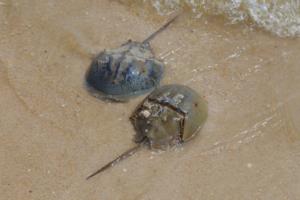Science & Technology
/Knowledge

Environmentalists push back against US EPA plan to extend coal plant closings
The U.S. Environmental Protection Agency is facing strong public opposition to its proposed plans to extend closure deadlines until October 2031 for 11 coal plants across the country — three of which are in Illinois and one in northwest Indiana.
But many environmental experts, including Earthjustice senior attorney Mychal Ozaeta, say the ...Read more

AI dominates as CES 2026 opens in Las Vegas
Artificial intelligence dominated the conversation as CES 2026 opened Tuesday. Nearly every major exhibitor framed AI as a tool that can make daily routines smoother, faster and more efficient.
The emphasis was less on far-off science fiction and more on practical systems designed to improve how people live and work right now.
The four-day ...Read more

Environmentalists sue feds to protect 'prehistoric' crabs that frequent South Carolina coast
COLUMBIA, S.C. — Environmentalists are suing the federal government over what they say is a failure to protect the horseshoe crab, a prehistoric looking species that is important to the survival of shore birds in South Carolina and other coastal states.
The Center for Biological Diversity says the National Marine Fisheries Service has not met...Read more

Universal partners with Nvidia on AI music creation, discovery
Universal Music Group NV is partnering with Nvidia Corp. to boost the role of artificial intelligence in music discovery and creation, as record labels seek to capitalize on the fast-growing technology while managing the risks AI poses to their catalogs.
The collaboration between the world’s largest record label and the leading AI chipmaker ...Read more

Defying Trump's NASA proposal, Congress looks to maintain budget, including science, near current levels
Last year President Donald Trump pitched a severe chop to NASA’s proposed annual budget for 2026, but the House and Senate on Monday released an appropriations bill that would mostly ignore those cuts.
The minibus bill put forth by both congressional bodies’ appropriation committees includes NASA as well as the National Oceanic and ...Read more

Where a Saudi company pumps desert groundwater, Arizona considers imposing limits
VICKSBURG, Ariz. — Lush green fields of alfalfa spread across thousands of acres in a desert valley in western Arizona, where a dairy company from Saudi Arabia grows the thirsty crop by pulling up groundwater from dozens of wells.
The company, Fondomonte, is the largest water user in the Ranegras Plain groundwater basin, shipping hay ...Read more

California's largest reservoir rises 36 feet as rains boost water supply statewide
When it rains, it pours. And that’s good news for California’s water supply.
After a relatively slow start to the winter rainy season, a series of atmospheric river storms has sent hundreds of billions of gallons of water pouring into reservoirs across California over the past three weeks, easing the concerns of water managers and ...Read more

Orlando confirms avian flu to blame for Lake Eola swan deaths as toll hits 19
ORLANDO, Fla. — The number of swans that have died in the avian flu outbreak at Orlando’s Lake Eola Park has spiked to 19, city officials said Monday.
Since discovering the first deaths in December, the city has operated under the assumption that avian flu was to blame – though only in recent days did it receive official confirmation ...Read more

Robotic puppy, AI, wearable technology on display at CES media preview
Hundreds of the roughly 4,000 media members attending CES 2026 got an early look Sunday at some of the thousands of consumer electronics gadgets that will dominate multiple trade show floors across the city this week.
The annual Consumer Electronics Show, sponsored by the Virginia-based Consumer Technology Association opens Tuesday, but media ...Read more
Butterflies, snakes and flowers: In rugged Baja canyons, San Diego scientists unlock an unsung region's biodiversity
Sulphur butterflies glide across Zorrillo Canyon, hundreds of them, moving back and forth against the cerulean sky. It’s nothing short of a fairy wonderland for the scientists below.
At least, that’s how Jon Rebman, curator of botany at the San Diego Natural History Museum, describes it as he begins the hike into the canyon on a late ...Read more

Editorial: The Trump administration misapplies federal law to keep open coal-fired plants in Indiana
The Trump administration is badly stretching the law to keep open coal-fired power plants throughout the Midwest that otherwise would have shuttered under well-thought-out, long-term strategies.
The latest examples are in neighboring Indiana, where the Department of Energy late last month ordered utilities not to close two aging power stations ...Read more

SpaceX lines up 1st Space Coast launch of the year
ORLANDO, Fla. — The Space Coast’s first launch of the year could come at midnight Sunday, the first of what could be four launches in the next 10 days, all from SpaceX.
A Falcon 9 is set to lift off on the Starlink 6-88 mission with 29 Starlink satellites from Cape Canaveral Space Force Station’s Space Launch Complex 40 during a launch ...Read more

Elon Musk company bot apologizes for sharing sexualized images of children
Grok, the chatbot of Elon Musk's artificial intelligence company xAI, published sexualized images of children as its guardrails seem to have failed when it was prompted with vile user requests.
Users used prompts such as "put her in a bikini" under pictures of real people on X to get Grok to generate nonconsensual images of them in ...Read more
Nearly every corn seed planted in Colorado is covered in insecticide. Lawmakers may restrict the chemical
DENVER — Colorado farmers plant tens of millions of corn seeds every year, nearly every one of them covered in a thin layer of insecticide.
The neonicotinoids used in the coatings protect the seed from pests in the soil and, as the crop matures, the chemical is absorbed into the plant’s tissue, where it continues to paralyze and kill ...Read more
$40 million campaign launched to save pristine NC game lands from development
Conservationists launched a $40 million campaign Thursday to save 4,000 acres of pristine North Carolina game land from development.
The owner of the land along the Yadkin River between Salisbury and Albemarle allowed public access to hunters, anglers and others for years before recently deciding to sell the property, officials with Salisbury-...Read more

Judge finds Alaska's bid to reauthorize wolf-shooting program on Kenai Peninsula is unconstitutional
A judge has ordered the Alaska Department of Fish and Game to pay $115,220 in attorney's fees to a retired Anchorage lawyer and wildlife advocate who successfully sued the state over a wolf-killing policy on the southern Kenai Peninsula.
Anchorage Superior Court Judge Una Gandbhir found the state violated the Alaska Constitution when it ...Read more

How a San Diego startup's universal flu shot sold for $9 billion
Inside a single-story brick building in Sorrento Mesa is a small lab sprinkled with beakers, test tubes and incubators that is worth billions of dollars.
This is where Cidara, a small San Diego pharmaceutical company, created what the scientific community has talked about for decades — a kind of universal flu shot that fights all forms of ...Read more
How artificial intelligence became real estate's new secret weapon
CRANBERRY TOWNSHIP, Pennsylvania — Coldwell Banker agent Georgie Smigel used to spend hours digging through spreadsheets and old inquiry lists trying to figure out who might be interested in a new listing.
Now she simply asks her artificial intelligence software who is looking for a $250,000 house in a given Pittsburgh neighborhood or suburb....Read more

Trump administration orders coal-burning power plant in Colorado to stay open
DENVER — The Trump administration, in its ongoing push to boost fossil fuels, issued an emergency order Tuesday to keep an aging coal-fired power plant in Craig, Colorado, operating even though it was scheduled to be retired this week.
The move was criticized by Colorado environmentalists, who said it will cost utility ratepayers and harm ...Read more

Delhi's worst air in years fuels anger in test for Modi's party
India’s capital recorded its worst pollution in nearly a decade this winter, sparking rare public protests and criticism of Prime Minister Narendra Modi’s party over its handling of the air quality emergency.
In November and December, when pollution in New Delhi typically peaks, the air quality index was above 300 on 88% of days, according ...Read more
Popular Stories
- Defying Trump's NASA proposal, Congress looks to maintain budget, including science, near current levels
- Universal partners with Nvidia on AI music creation, discovery
- Environmentalists sue feds to protect 'prehistoric' crabs that frequent South Carolina coast
- Where a Saudi company pumps desert groundwater, Arizona considers imposing limits
- Robotic puppy, AI, wearable technology on display at CES media preview





